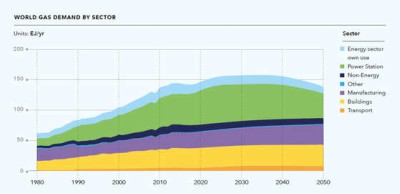DNV GL: Gas to become world's primary energy source by 2035
DNV GL’s Energy Transition Outlook (ETO), a forecast that spans the global energy mix to 2050, predicts that global demand for energy will flatten in 2030, then steadily decline over the next two decades, thanks to step-changes in energy efficiency. The fossil fuel share of the world’s primary energy mix will reduce from 81% currently to 52% in 2050.
 |
| Courtesy of DNV GL. |
Demand for oil will peak in 2022, driven by expectations for a surge in prominence of light electric vehicles, accounting for 50% of new car sales globally by 2035. However, the stage is set for gas to become the largest single source of energy towards 2050, and the last of the fossil fuels to experience peak demand, which DNV GL expects will occur in 2035.
Gas will continue to play a key role alongside renewables in helping to meet future, lower-carbon, energy requirements. Major oil companies intend to increase the share of gas in their reserves, and DNV GL expect an accelerated shift by 2022 as they decarbonize business portfolios.
While demand for hydrocarbons will peak over the next two decades, significant investment will be needed to add new oil and gas production capacity and operate existing assets safely and sustainably. However, the results of DNV GL’s model reinforce the need to maintain strict cost efficiency in order to achieve the margins necessary for future capital and operational expenditure.
“Increased digitalization, standardization and remote or autonomous operations will play a central role in achieving long-term cost savings and improving the oil and gas industry’s carbon footprint. We also expect the industry to turn to innovations in facility design, operating models and contracting strategies,” said Elisabeth Tørstad, CEO, DNV GL – Oil & Gas.

- ADNOC Gas awards $2.1 B in contracts to enhance LNG supply infrastructure
- U.S. Department of the Treasury releases final rules for clean hydrogen production tax credit
- Topsoe, Aramco sign JDA to advance low-carbon hydrogen solutions using eREACT™
- Nicor Gas celebrates its first renewable natural gas interconnection
- EnviTec Biogas looks to expand biogas production into the U.S.



Comments